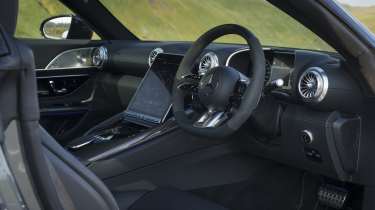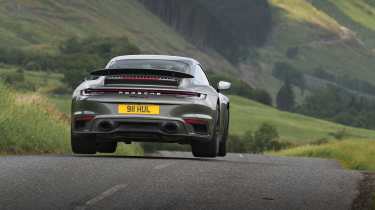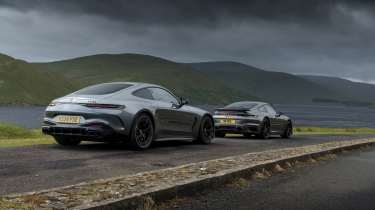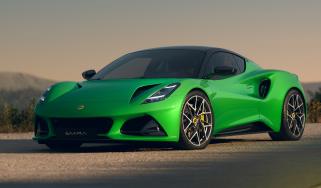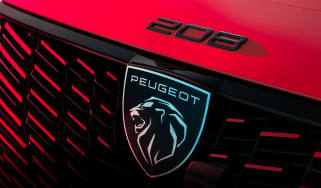Mercedes-AMG GT 63 v Porsche 911 Turbo S: all-wheel drive GTs go head-to-head
Has the latest 577bhp AMG GT got what it takes to challenge the mighty 641bhp 911 Turbo S as the consummate super‑GT? A coast-to-coast drive on wonderful Borders roads should reveal all
This is a first: waiting for the tide to go out so that we can start a test. North Sea waves are still gently lapping at the edges of the tarmac strip that we want to drive, so, without any Canute-like inclinations, we’ve got to hang fire for a while. Everything else is pretty much situation normal, however, with James, Dean (it would be very much not normal without that comma) and me hanging around in the parking area behind a petrol station, cleaning cars and eating confectionary of various flavours.
The machines on the receiving end of the microfibre cloths and medicinal-smelling bug spray both pose intriguing questions, even if they’re not immediately obvious. In what sense is a Porsche 911 Turbo S thought-provoking? An instantly recognisable, generations-deep cornerstone of the performance car landscape is surely about as fundamental as it gets. Just a benchmark for the Benz. Except that I wonder if the Turbo is teetering on the edge of a little bit of a crisis. Performance and cross-country pace with a dose of practicality have been the central tenets of the 911 Turbo ever since it went four-wheel drive in the mid‑’90s with the 993. It wasn’t the 911 you bought for the best soundtrack or to attract attention, or for the most engaging handling. But it was noticeably quicker than pretty much anything else.
More reviews
Group tests
In-depth reviews
Reviews
> Mercedes-AMG GT 63 Pro 2024 review – a four-seat 911 GT3 rival?
Now there are a host of practical EVs with performance that can effortlessly match the snail-supplemented 911 icon. Some of them even have Porsche and Turbo badges on. There are other family challengers too, because where once there was clear water between a Carrera 4S and a Turbo in terms of performance, now it feels like the cheaper car is nipping harder on the heels of the Turbo than ever before. And both have turbos.
Anyway, as a reminder of what our Aventurine Green incarnation of 911 HUL is bringing to the table, the Turbo S’s 3745cc flat-six produces 641bhp and 590lb ft of torque, which it sends through an eight-speed PDK gearbox and reins in with carbon-ceramic brakes. The all-wheel drive (PTM in Porsche parlance) is via a central multi-plate clutch with an e-diff at the rear. In addition to the £180,600 base price, this car also has £5k of Heritage Design Package, £3k of other sundry design tweaks, £2500 of sports exhaust, £1385 of adaptive cruise control and £842 of Park Assist with Surround View, taking the total to the best part of £194,000.
In the Selenite Grey corner is the new Mercedes-AMG GT63 4Matic+ Premium Plus. And despite the long-winded name (which reads like a combination of a laptop and an aeroplane seat), this £164,905 model is actually the standard trim for the 63 (Ultimate and Launch Edition being the pricier options). Not that it is exactly sparse on the spec; we’re simply doing without carbon-ceramic brakes and a fixed rear wing.
Under the bonnet is the familiar M177 4-litre, turbocharged V8 (albeit better cooled and slightly freer breathing) putting out slightly less power than the Porsche at 577bhp but an identical 590lb ft of torque through an MCT nine-speed automatic transmission. This gearbox is now mounted just behind the engine as opposed to the old GT’s transaxle layout, shifting the weight distribution from 47:53 to 54:46. Also unlike the previous AMG GT, this new car sends the power to all four wheels through an electro-mechanically controlled clutch teamed with an e-diff at the rear.
But why are we waiting for the tide to recede? Well, we’re just south of the border between England and Scotland, a portion of the country that is home to some of our favourite roads anywhere in the world. But we’re going to change things around a little. I’ve always thought of this area in a sort of north-south orientation, with different corridors running between England and Scotland. However, I reckon it would be pretty fun to drive across the Borders and Dumfries and Galloway, east to west, sea to sea. And if we’re doing that, we might as well start as far east as we can, on Holy Island. It’s not technically the Borders, but there are more photo opportunities than at Burnmouth.
Anyway, with the water now in full retreat it’s time to get going. There is something rather thrilling about driving out on the causeway with the shallows and seaweed either side. Glancing in the Porsche’s rear-view mirror, the Mercedes’ gaping grille looks rather piscine in a predatory sort of way, like it wants to hoover up some krill. Overall, though, it’s a good-looking car, with smooth surfacing bringing a modern polish to a familiar, front-engined formula. As deputy editor Taylor commented at the petrol station, ‘It’s a bit more amorphous than before, but I think they’ve kept a lot of the drama of its predecessor. It could only be an AMG GT.’
After a few runs for the drone we leave the increasingly sandy scenery behind and head off to the roads that we have really travelled up here for. This eastern side of the Borders is one that we’ve used less over the years at evo because it lacks the mini-Highlands feel of some of the central and western portions. However, this area is special to me because it is the setting for the Jim Clark Rally. A detour to Duns and the museum dedicated to the farming F1 world champion is always a treat, but so are the roads that make up stages like Leitholm, Abbey St Bathans, Eccles and Bothwell.
It’s over a decade since I last competed in the rally (in a Twingo with about a fifth of the power of either of these cars!) but nonetheless I still find the memories come flooding back just from a recognisable junction or a particular set of bends. The sight of a sign for Swinton conjures the smell of washer fluid and a slight phantom stiffness in the neck – the village’s crossroads being the site of a famous jump that has a fairly nose-heavy, uphill landing.
I’m sure a stock Turbo S could set some pretty impressive stage times. Sport mode feels like it is neither one thing nor the other, so I find myself skipping from Normal straight to Sport Plus when the road opens up and then back again for the villages. My only worry about the most aggressive setting is that it extends the aero, and while the rear wing being up isn’t a problem I do wonder initially if the rubber petticoat that drops down from the nose might catch through compressions. Thankfully the first savagely lumpy section of road elicits no scuffing or scraping so I feel I can press on without fear of doing damage.
Although grip in the corners is prodigious, there is still a rear-engined nuance to the way the 911 wants to be driven. It’s not that it understeers at road speeds, but there is a sense that you need to just wait a bit for the front end in corners before getting back on the throttle and feeling it squat at the rear as you accelerate hard.
As James says, ‘It has that 911 diagonal rocking motion in more abundance than our Fast Fleet Carrera GTS, which I suspect is partly because of the heavier engine and partly because of the Turbo S’s slightly more grown-up ride.’ I know what he means about the ride; this car has standard rather than optional Sport suspension and it’s just a touch more pliant, which I think suits the car’s character better.
Swapping into the AMG, the GT doesn’t get off to a great start because my initial instinct is to reach for the seat controls to try to sink myself lower. It’s a nicely bucketed seat but the whole thing is just a little high. As a result you find yourself fiddling with the backrest during the first few miles to try to improve the position. It’s perhaps unfortunate that it’s being juxtaposed with a 992-generation 911, in which you can slam the driver’s seat so far that even I feel like I might struggle to see over the dash.
The rest of the Mercedes’ interior is very modern and tech-heavy after the Porsche. I love the backlit turbine vents but, a bit like the enormous 11.9-inch touchscreen, I do worry that they are a touch too trendy and will age quickly as a result. However, the sheer size of that screen and the fact it’s positioned some way aft of the dash means that it is easy to reach and navigate once you’ve cottoned on to the individualities of the operating system. Spend a while browsing the various menus and you’ll find some lovely graphics and animations too. Entertaining if you’re not actually doing any driving.
Fire up the V8 and the GT’s soundtrack scores a direct hit on the Porsche. No contest, it’s more instantly, grumblingly appealing. At low speeds as I shuffle out of the car park, the effect of the rear-wheel steering is very obvious too, with an almost double-jointed feeling of manoeuvrability that gives you a sense that you’re actually driving something smaller than the view over the big bonnet suggests.
Heading towards Hawick, confidence grows at a remarkable rate. Where the old, rear-wheel-drive GT was a car that took a while to acclimatise to, sitting behind its long, low nose and almost on the rear axle, this new car has an amazing accessibility to its performance. The front end is fantastically responsive and quick-witted, but there is also incredible traction from the four-wheel-drive system, so it has an encouraging, secure agility to it. The only initial peculiarity is that there is a curious resistance when you unwind steering lock. It’s like battling a bit of torque steer in a front-wheel-drive car.
Nevertheless, within a few corners you sense this is an AMG that you can easily extract pace from and I know that James will be having to work much harder in the Porsche to match the Mercedes as we wind our way slightly south. The sound at speed is a little synthetic, which is a shame and unusual for this engine, but there are some good cracks and crackles as the pipework gets hot and you can really access all the revs.
We’re zig-zagging across the countryside like a dinghy tacking into wind, but the consistent quality of the roads is fabulous. I love the variety and also the challenge they present both for driver and car, with cambers, bumps and sometimes jumps to really stretch and test. If a car is going to be tied in knots then there are sections that will hitch reefs to bowlines and finish with the chassis in a sheepshank. Yet there are other segments that meander smoothly and flatteringly in the most wonderful way. One stretch in particular that I remember from past eCotys has a series of shallow, well-sighted, positively cambered bends that thread between the verges in a delicious flow. Even better is that I know our route is one of several that we could have chosen to travel from coast to coast.
We pause at Megget Reservoir to have a snack and a drink and James, who clearly spent his formative years confined to a cupboard under the stairs like Harry Potter, suggests he’d like to have a go at sitting in the back seats of each car. After a spot of automotive spelunking, he emerges, stretches and declares the Mercedes the winner in terms of space. You can fold the rear seats down in both cars if you want, and in the rear-hatched Mercedes in particular this makes for a pretty practical luggage space.
Hopping back into the Pepita-trimmed driver’s seat of the Porsche, I’m immediately struck by the greater sense of connection and weight to the controls. The thinner-rimmed wheel, the more mechanical nature of the PDK ’box and the firmer secondary ride immediately make it feel more tactile and involving. After initially thinking that they were probably level-pegging for accelerative pace, it’s also now clear that the Porsche has the marginal upper hand thanks to its more demonstrative turbocharged punch as the boost hits. It is also some 255kg lighter than the 1895kg AMG, which helps.
There is a somewhat old-school sense of the turbocharged elastic being stretched before the catapult is released, and this is what sets the big-T Turbo apart from little-t turbo 911s. It feels less sophisticated and (despite this car’s sports exhaust) sounds less appealing, but there is something uniquely heady about its mighty, full-throttle thump-squeeeeeze to the thorax.
The Turbo certainly requires increased input and thought to pilot it quickly through the corners too, but it’s not a chore. You not only need to work with the weight transfers more – pausing, shifting, lifting – you also need to be more positive with the all-wheel-drive system, really using the throttle quite aggressively to put power through the shafts and get the car up on its toes and turning to greatest effect. It’s exciting and the cross-country pace is certainly impressive.
But another seat-switch back to the Mercedes in Moffat reveals that the GT isn’t done yet. We head up towards the wonderfully named Devil’s Beeftub, then across to more eCoty roads on the other side of the A74(M). Here we tackle another mini-rollercoaster of a road with short, sharp yumps and a fairly broken surface, yet the Mercedes seems impervious to the tests being hurled at its suspension. I had thought that this would finally be the undoing of the nearly two-ton GT, but body control remains intact and even when I fly it over a crest into a mini-crater, it copes with aplomb.
There is a smooth agility to it that is quite remarkable. Combined with a tenacity under throttle that is really the opposite of what you would expect from an AMG, the GT is capable of devastating poise and pace. The impressed:involved ratio is definitely weighted to the former, with the big Michelins remaining firmly laterally located at all times, but that doesn’t mean the GT isn’t enjoyable. In fact, when I discuss it with James later, he’s more than a little smitten: ‘Weirdly, although the 911 is by far the more involving car, I think…’ and there is a pause at this point ‘…I would actually choose the AMG for one last blast on an amazing bit of road. You’re less involved in the process, but I was slightly in awe of what it could do.’
Although I’d choose the Turbo S in the same scenario, I know exactly what he means. I think some of the AMG’s magic might result from the switch to forged aluminium for the suspension arms, wheel carriers and steering knuckles, which has reduced unsprung mass. However, I suspect even more witchcraft stems from the Active Ride Control. Yes there are new adaptive twin-valve dampers to go with new, lighter springs, but they have probably been granted extra freedom by the ARC. This semi-active interlinked hydraulic system replaces traditional anti-roll bars, essentially giving much greater independence, when necessary, to each individual wheel. Whatever the root reason, the result is a damping deftness that is truly impressive.
The Galloway Forest and the final run in darkness to the Irish Sea allow us a couple more changes of cockpit, but they merely cement our feelings about these two cars. They also affirm my belief that this slice of the UK has one of the richest, most demanding networks of roads imaginable. If a car is enjoyable here, it will surely be enjoyable pretty much anywhere.
It has been a very good test, but trying to pick a winner from the two cars is as tricky as choosing a favourite stretch of tarmac on our route, because it’s all a matter of perspective. If you view this head-to-head as a battle between grand tourers then the Mercedes is the car for you. James and I did a five-hour motorway stretch in each car and we both agreed that the NVH was noticeably less in the AMG, making it undoubtedly the easier, more relaxing car to do a long journey in (regardless of whether or not you make use of the rather terrific – and standard – massage seat functions). Yet the AMG also has pace and poise aplenty when you reach a good bit of road, never getting left in the wake of its fellow Stuttgart son. It looks like a classic GT and it is.
However, I suspect many of you may have viewed this test in a subtly different light – as an examination of whether AMG has built a car to beat the benchmark that is the 911 Turbo. And the 911 Turbo is not a GT car, it is an everyday, all-weather supercar. If you regard its levels of driver involvement, tactility and handling nuance as part of the attraction, then you’ll think the Mercedes just a touch too remote. Capable but not as characterful. To that extent I don’t think it would have made any difference if we’d had a standard Turbo (which would have been a closer match on price and power, if not torque) rather than an S. The extra power isn’t the defining factor here.
What might have been interesting would have been throwing in another German, four-seat performance car with similar figures and AWD: the BMW M5 CS would, I suspect, have been the perfect blend. But you can only beat what is in front of you, and despite James favouring the AMG for a final fling on a perfect bit of road, we’re both agreed that the 911 is the car we would choose to own, simply because it would be more involving more of the time, whatever the road. The tides of change may mean the future is a little uncertain for the 911 Turbo but, for now, it’s still holding on.
| Mercedes-AMG GT63 | Porsche 911 Turbo S | |
| Engine | V8, 3982cc, twin-turbo | Flat-six, 3745cc, twin-turbo |
| Power | 577bhp @ 5500-6500rpm | 641bhp @ 6750rpm |
| Torque | 590lb ft @ 2500-5000rpm | 590lb ft @ 2500-4000rpm |
| Weight | 1895kg | 1640kg |
| Power-to-weight | 309bhp/ton | 397bhp/ton |
| Tyres | Michelin Pilot Sport S 5 | Pirelli P Zero |
| 0-62mph | 3.2sec | 2.7sec |
| Top speed | 196mph | 205mph |
| Basic price | £164,905 | £180,600 |
This story was first featured in evo issue 324.



